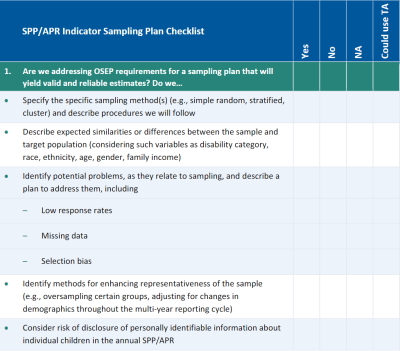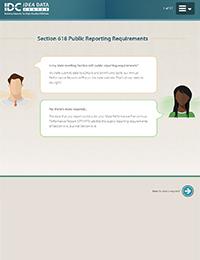
Resource Library
Guides. Briefs. Toolkits. Quick reference information. IDC and its partners created these data quality resources to help states better prepare to address their existing or emerging IDEA data quality needs. Use our search and filtering tools to navigate the library.
Resources 1 - 7 of 36
Format: Guides and Briefs
Parent Involvement Data: How to Measure and Improve Representativeness for Indicator B8This interactive resource provides states with an overview on how to gather representative parent involvement data for Part B SPP/APR Indicator 8. The resource defines key concepts such as representativeness, sampling, nonresponse bias, response rates, and weighting. It also offers information on how to improve the quality of parent involvement data, including strategies that can help states collect representative data and evaluate and improve the representativeness of their data before, during, and after data collection.
Format: Quick Reference
SPP/APR Indicator Sampling Plan ChecklistStates are allowed to use sampling for collecting data for select Part B State Performance Plan/Annual Performance Report indicators. Sampling can provide an effective means for targeting resources for data collection and improving data quality. However, there are important requirements that states must consider when designing and implementing their sampling plans. States can use this interactive self-assessment tool to determine whether their state’s sampling plan addresses Office of Special Education Programs sampling requirements for best practice and to identify action steps to improve their sampling procedures.
Format: Applications and Spreadsheets
Nonresponse Bias Analysis ApplicationThe NRBA App is an interactive nonresponse bias application powered by state-of-the-art statistical software. We developed this application to help states examine their SPP/APR Indicator 8 and Indicator 14 data through nonresponse bias analysis. The NRBA App allows users to conduct reproducible analyses of response rates, representativeness, and nonresponse bias, tailored to their survey’s data collection method.
Format: Applications and Spreadsheets
Section 618 Public Reporting RequirementsThis tool provides an overview of the public reporting requirements for IDEA Section 618 and processes for fulfilling the requirements. The tool annotates Section 618 legislation to name relevant data collections, file specifications documents, and user guides. Through a question-and-answer format, the tool highlights common processes and critical considerations to complete the requirements and points to external resources for further support.
Format: Guides and Briefs
Success Gaps Rubric: Addressing Equity, Inclusion, and OpportunityThis rubric allows a team of users from a district or school to systematically examine the root causes of success gaps among groups of students by focusing on equity, inclusion, and opportunity. The recently updated rubric now includes considerations for children as young as preschool age. A complementary white paper provided the research-based background that supported development of the rubric.
Format: Guides and Briefs
Measuring Significant Discrepancy: An Indicator B4 Technical Assistance GuideThe TA guide describes the methods a state might use to appropriately determine which of its districts has a significant discrepancy (including a significant discrepancy by race or ethnicity) in the rates of out-of-school suspensions and expulsions totaling greater than 10 days for children with disabilities.
Format: Guides and Briefs
Methods for Assessing Racial/Ethnic Disproportionality in Special EducationThis TA guide addresses the more common methods for calculating racial/ethnic disproportionality in special education. IDC revised the guide, which the Data Accountability Center (DAC) originally published in October 2011, because of a change in SPP/APR Indicators 9 and 10 to remove underrepresentation from the measure.








